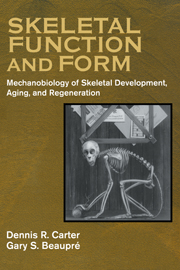Book contents
- Frontmatter
- Contents
- Preface
- Chapter 1 Form and Function
- Chapter 2 Skeletal Tissue Histomorphology and Mechanics
- Chapter 3 Cartilage Differentiation and Growth
- Chapter 4 Perichondral and Periosteal Ossification
- Chapter 5 Endochondral Growth and Ossification
- Chapter 6 Cancellous Bone
- Chapter 7 Skeletal Tissue Regeneration
- Chapter 8 Articular Cartilage Development and Destruction
- Chapter 9 Mechanobiology in Skeletal Evolution
- Chapter 10 The Physical Nature of Living Things
- Appendix A Material Characteristics
- Appendix B Structural Characteristics
- Appendix C Failure Characteristics
- Index
Chapter 3 - Cartilage Differentiation and Growth
Published online by Cambridge University Press: 11 January 2010
- Frontmatter
- Contents
- Preface
- Chapter 1 Form and Function
- Chapter 2 Skeletal Tissue Histomorphology and Mechanics
- Chapter 3 Cartilage Differentiation and Growth
- Chapter 4 Perichondral and Periosteal Ossification
- Chapter 5 Endochondral Growth and Ossification
- Chapter 6 Cancellous Bone
- Chapter 7 Skeletal Tissue Regeneration
- Chapter 8 Articular Cartilage Development and Destruction
- Chapter 9 Mechanobiology in Skeletal Evolution
- Chapter 10 The Physical Nature of Living Things
- Appendix A Material Characteristics
- Appendix B Structural Characteristics
- Appendix C Failure Characteristics
- Index
Summary
Tendon Development and Fibrocartilage Metaplasia
The soft connective tissues can be considered both histomorphologically and mechanically as a broad range of tissues consisting of various amounts of proteoglycans, water, and structural proteins that are organized with specific ultrastructural arrangements. The composition and ultrastructural organization of these tissues are exquisitely matched to the loading histories to which they are exposed. In general terms, we find that the collagen fiber orientations in fibrous tissues correspond to the predominant direction of in vivo tensile stresses (Figure 3.1). In structures wherein compression is imposed in directions perpendicular to the direction of primary tensile loading, the cells and extracellular matrix manifest the more chondroid character of fibrocartilage. Articular cartilage, on the other hand, is exposed primarily to compressive loading from the joint surface. Since cartilage behaves as a nearly incompressible material at physiologic loading frequencies (1 hz), the adjacent cartilage material effectively provides a tangential compressive stress under the region of contact (Figure 3.1). High hydrostatic pressure is thereby created under the contact area (Figure 2.9). Significant developmental modulations in phenotype, tissue organization, and geometry are possible in tendon, ligaments, menisci, intervertebral discs, articular cartilage, and other soft connective tissue structures. The local mechanical loading history plays a major role in regulating these modifications and thereby “designing” tissues and structures that are matched to their mechanical environment.
To illustrate the role of mechanobiology in dense connective tissue, we can consider the development and adaptation of tendons. During growth and development, tendons will experience changes in both composition and geometry. In particular, progressive increases are observed in the volume fraction of collagen and the size of the tendons.
- Type
- Chapter
- Information
- Skeletal Function and FormMechanobiology of Skeletal Development, Aging, and Regeneration, pp. 53 - 72Publisher: Cambridge University PressPrint publication year: 2000

